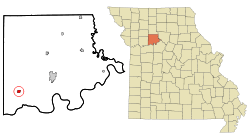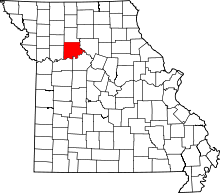Norborne, Missouri
| Norborne, Missouri | |
|---|---|
| City | |
 Location of Norborne, Missouri | |
| Coordinates: 39°18′8″N 93°40′34″W / 39.30222°N 93.67611°WCoordinates: 39°18′8″N 93°40′34″W / 39.30222°N 93.67611°W | |
| Country | United States |
| State | Missouri |
| County | Carroll |
| Area[1] | |
| • Total | 0.65 sq mi (1.68 km2) |
| • Land | 0.65 sq mi (1.68 km2) |
| • Water | 0 sq mi (0 km2) |
| Elevation | 689 ft (210 m) |
| Population (2010)[2] | |
| • Total | 708 |
| • Estimate (2012[3]) | 689 |
| • Density | 1,089.2/sq mi (420.5/km2) |
| Time zone | Central (CST) (UTC-6) |
| • Summer (DST) | CDT (UTC-5) |
| ZIP code | 64668 |
| Area code(s) | 660 |
| FIPS code | 29-52760[4] |
| GNIS feature ID | 0723412[5] |
Norborne is a city in Carroll County, Missouri, United States. The population was 708 at the 2010 census.
Norborne was founded in 1868, by Norborne B. Coates, a civil engineer for the railroad. The town has numerous small businesses but is mostly an agricultural community. Norborne is the self-proclaimed Soybean Capital of the World and holds a Soybean Festival every year during the weekend of the second Saturday in August.
In June 2009, Norborne, Missouri was hit by straight-line winds in excess of 74 mph (miles per hour) which severely damaged buildings, homes and property.
Geography
Norborne is located at 39°18′8″N 93°40′34″W / 39.30222°N 93.67611°W (39.302268, -93.676040).[6]
According to the United States Census Bureau, the city has a total area of 0.65 square miles (1.68 km2), all of it land.[1]
Demographics
2010 census
As of the census[2] of 2010, there were 708 people, 306 households, and 185 families residing in the city. The population density was 1,089.2 inhabitants per square mile (420.5/km2). There were 367 housing units at an average density of 564.6 per square mile (218.0/km2). The racial makeup of the city was 95.3% White, 2.1% African American, 0.7% Native American, 0.1% from other races, and 1.7% from two or more races. Hispanic or Latino of any race were 1.3% of the population.
There were 306 households of which 29.4% had children under the age of 18 living with them, 41.8% were married couples living together, 9.8% had a female householder with no husband present, 8.8% had a male householder with no wife present, and 39.5% were non-families. 34.6% of all households were made up of individuals and 19.6% had someone living alone who was 65 years of age or older. The average household size was 2.31 and the average family size was 2.97.
The median age in the city was 40.5 years. 23% of residents were under the age of 18; 8.8% were between the ages of 18 and 24; 23.5% were from 25 to 44; 27.5% were from 45 to 64; and 17.2% were 65 years of age or older. The gender makeup of the city was 47.2% male and 52.8% female.
2000 census
As of the census[4] of 2000, there were 805 people, 358 households, and 220 families residing in the city. The population density was 1,285.0 people per square mile (493.4/km²). There were 404 housing units at an average density of 644.9 per square mile (247.6/km²). The racial makeup of the city was 95.16% White, 3.60% African American and 1.24% Native American. Hispanic or Latino of any race were 0.99% of the population.
There were 358 households out of which 28.2% had children under the age of 18 living with them, 50.0% were married couples living together, 6.4% had a female householder with no husband present, and 38.3% were non-families. 34.6% of all households were made up of individuals and 20.4% had someone living alone who was 65 years of age or older. The average household size was 2.25 and the average family size was 2.93.
In the city the population was spread out with 25.0% under the age of 18, 7.7% from 18 to 24, 24.2% from 25 to 44, 22.4% from 45 to 64, and 20.7% who were 65 years of age or older. The median age was 40 years. For every 100 females there were 90.3 males. For every 100 females age 18 and over, there were 81.9 males.
The median income for a household in the city was $25,208, and the median income for a family was $31,488. Males had a median income of $24,821 versus $18,393 for females. The per capita income for the city was $14,526. About 11.1% of families and 15.8% of the population were below the poverty line, including 21.1% of those under age 18 and 15.2% of those age 65 or over.
Notable natives
- Harold L. Wright Vice president, F. W. Woolworth Co.
- Bob Walkenhorst, singer, songwriter and member of The Rainmakers
- Max Lane Former NFL offensive lineman, New England Patriots
- James E. Craig Notable Essayist and Editor of the Editorial Page of the New York Sun
- Pauline Gracia Beery Mack, chemist
Norborne's History
Norborne was laid out in 1868.[7]
Norborne, Missouri was started as a railroad town. The first railroad to play an important part in the history of the area was the North Missouri Railroad. In 1862 the North Missouri Railroad was consolidated with the St. Louis, Kansas City and Northern Railroad. In 1879, another consolidation took place with the Wabash Railroad. The Santa Fe Railroad started its expansion east to Chicago, Illinois in 1874 and completed the route in 1878, forming the double tracks in Norborne. (Running from Carrollton, Missouri in the east to Hardin, Missouri in the west.)
Norborne B. Coates was born in Randolph County, Missouri, the son of Captain Thomas Coates, one of the earliest pioneer families of the Randolph County area. In 1868, Mr. Coates secured the position of land agent and surveyor for the North Missouri Railroad. He was also a notary public (with his signature on many old abstracts in Norborne). He came to the area in 1867 to contact owners of land and start negotiations for a right-of-way for the railroad. He surveyed land owned by John and Catherine Deitrich, purchased the railroad rights, then used his shrewd business talents to help plat a town on the site. Hence the name, NORBORNE. The town was incorporated in 1874 and reorganized under a new state law in 1878 to become a city of the fourth class. Norborne celebrated its centennial in 1968.
Education
School mascot is the Pirates.
References
- ↑ 1.0 1.1 "US Gazetteer files 2010". United States Census Bureau. Retrieved 2012-07-08.
- ↑ 2.0 2.1 "American FactFinder". United States Census Bureau. Retrieved 2012-07-08.
- ↑ "Population Estimates". United States Census Bureau. Retrieved 2013-05-30.
- ↑ 4.0 4.1 "American FactFinder". United States Census Bureau. Retrieved 2008-01-31.
- ↑ "US Board on Geographic Names". United States Geological Survey. 2007-10-25. Retrieved 2008-01-31.
- ↑ "US Gazetteer files: 2010, 2000, and 1990". United States Census Bureau. 2011-02-12. Retrieved 2011-04-23.
- ↑ Eaton, David Wolfe (1916). How Missouri Counties, Towns and Streams Were Named. The State Historical Society of Missouri. p. 271.
More references
External links
- Historic maps of Norborne in the Sanborn Maps of Missouri Collection at the University of Missouri
| |||||||||||||||||||||||||
